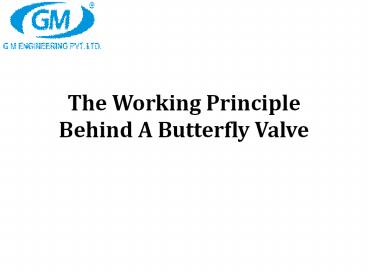Which principles are working behind the butterfly valve - PowerPoint PPT Presentation
Title:
Which principles are working behind the butterfly valve
Description:
The butterfly is a type of valve and it is used for the control the flow. It will use the metal disc. Here get the information about which principles are working behind the butterfly valve? – PowerPoint PPT presentation
Number of Views:38
Title: Which principles are working behind the butterfly valve
1
The Working Principle Behind A Butterfly Valve
2
INFORMATION
- A valve that can be used for regulating or
isolating the flow is called a butterfly valve. - This valve is used to open or close the circular
butterfly plate, which rotates with a pungent and
is used as a cut-off valve. - A butterfly valves manufacturers suggest that the
valve can be designed to have the function of
paragraph valve and adjust the disc.
3
Operation principle
- The more and more used valve in the low pressure
caliber pipes is cast iron butterfly valve. - The closing mechanism proceeds further in the
form of a disk. - The operation of a butterfly valve is quite
similar to that of a ball valve, which allows a
quick shut off. - The reason behind butterfly valves being commonly
favored in the industry is that they are lower in
cost as compared to the other valve designs as
well as lighter in weight. - Therefore, it requires less support. In the
center of the pipe, the disc is positioned,
through which the rod is connected to an actuator
passes. - The actuator, as it starts rotating, turns the
disc either perpendicular or parallel to the
flow. - The disk is always present within the flow, which
is not the case with a ball valve. - Therefore, regardless of the valve position, a
pressure drop is always induced in the flow.
4
Structure of the butterfly valves
- The structure of the butterfly valve is very
simple, small in size and light in weight with
only a few parts in them. - According to butterfly valves manufacturers, only
90-degree rotation is required for the valve to
be opened and closed quickly. - The electric valve, at the same time, has good
fluid control characteristics. - The thickness of the butterfly plate is the only
resistance when the medium flows through the
valve body and the valve is in a fully open
position. - As a result, the pressure drop generated by the
valve is very small and thereby it has better
flow control characteristics. - When the valve is closed, the disc is turned in
such a way that it fully blocks off the
passageway. - In case the valve is fully open, the disc is
rotated with a quarter turn, hence ensuring that
an almost unrestricted passage of the fluid is
allowed. - The valve, in some cases, may also be opened
incrementally to throttle flow.
5
Applications
- Butterfly valves are most economical for large
lines in water treatment, chemical services, and
fire protection systems. - General sizes available of the valve are 2 to
48', although for certain butterfly valves
manufacturers sizes up to 96 are available. - The butterfly valve is an economical choice for
larger line sizes due to the valve design,
including a small face-to-face dimension and
lower weight than most of the other valve types. - Face-to-face dimensions and pressure ratings of
the butterfly valves are complied with ASME,
which enables the valve to be easily retrofitted
in line regardless of the manufacturer. - The ASME pressure classes followed by most of the
butterfly valves manufacturers include 150, 300,
and 600 allowing a maximum pressure of 1500 psi. - Butterfly valves can be configured accordingly,
i.e. it can be configured to operate either
manually, electronically or pneumatically.
6
- The electronically operated valves need a signal
to the gearbox to both open or close. - Whereas for pneumatic valves, it can be either of
the two sides single or double actuated. - Also, they operate the most rapidly amongst
others. - Butterfly valves also come in with different
styles and shapes. - Large pump lines and front suctions are two
examples of butterfly valves that offer high
performance across various systems. - This was a detailed description concerning
butterfly valves and its various operating
principles, structure, and applications.
7
CONTACT US
www.gmengg.com
valve_at_gmengg.com
91 2827 287658 91 92280 0555891 92280 05559
G M ENGINEERING PRIVATE LIMITEDPlot No
2632G.I.D.C., LodhikaMetoda 360 021
(Rajkot).Gujarat INDIA

